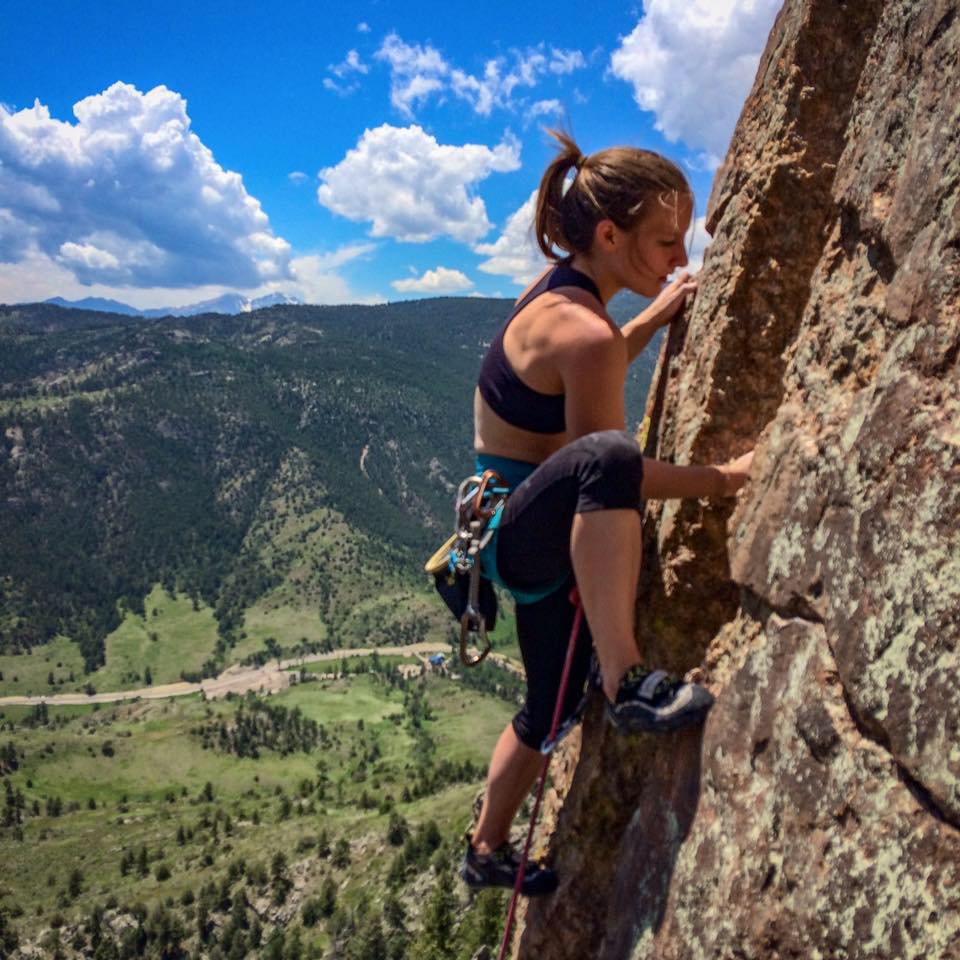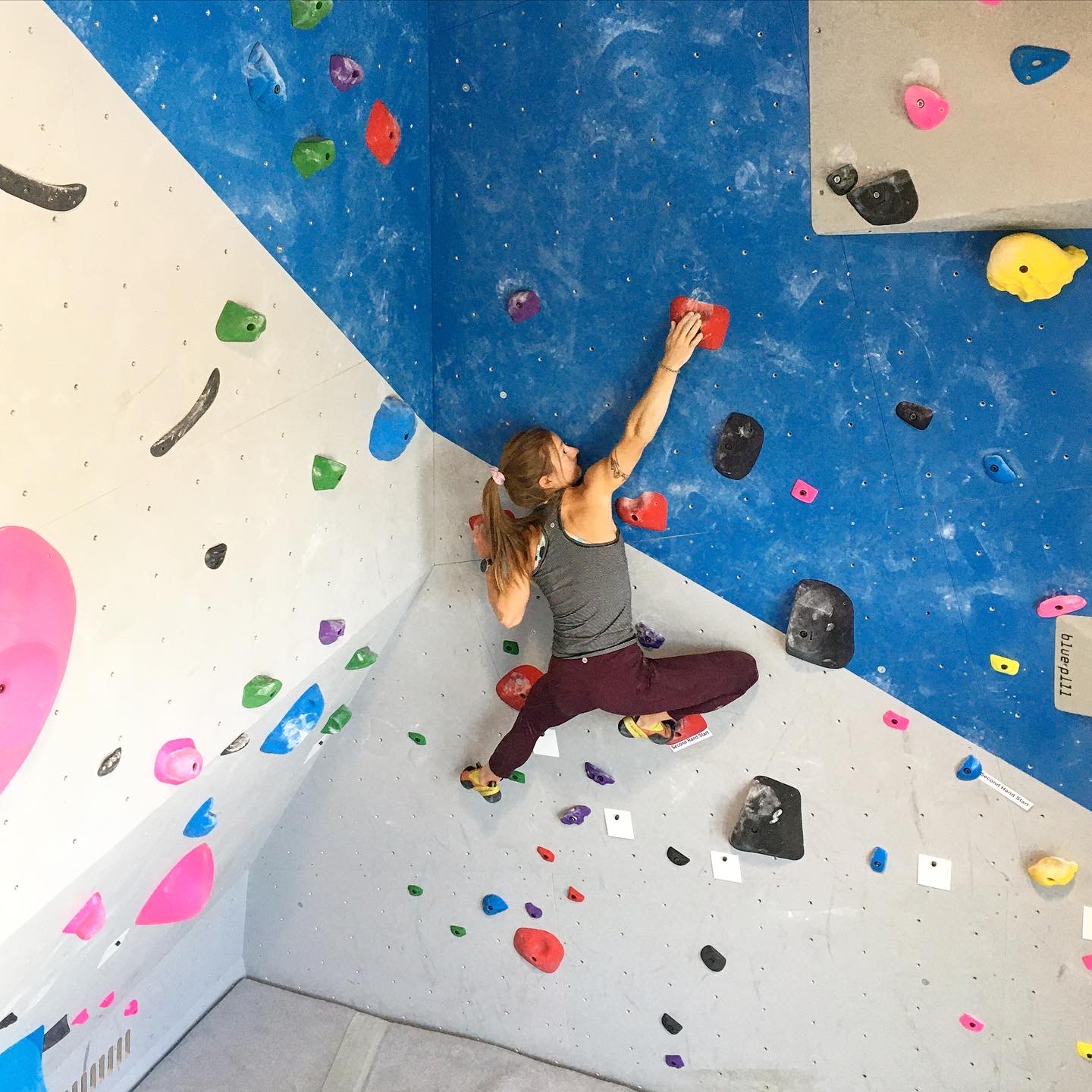Climbing for Mental Health
Saturday, January 2nd, 2021
Written by Lucie Hanes – Youth Programs Director, Head Coach, + Routesetter at Eagle Climbing + Fitness
Well-rounded health dives deep. While we’ve all spent the last year focusing so heavily on physical health amidst what seems like an onslaught of worldwide crises, it’s been all too easy to neglect a huge part of the equation. Mental health plays just as much of a role in the greater scheme of our health as all things physical, and connects right back to how we feel in our physical bodies. The way that we think and feel on a daily basis manifests in our actions and behaviors. Our mental state, however it may stand in the short or long term, can determine exactly how we show up in life.

I’m not shy about the fact that climbing has saved my life many times over, and that’s far from an exaggeration. I found climbing while in the throes of my first major mental health struggle as a young adult, and I truly believe that it is at least part of the reason I’m still here today. Not because of climbing itself, no matter how much I love the very act of it, but because of what climbing has taught me about my own strength. Every climbing session – hard or easy, send or fall, outdoors or inside, social or solo – reminds me of my internal fire. There is something vastly empowering about going against human instinct; we’re not really built to travel so high, balance on such small edges, or trust a freefall… and we do it anyway.
Note that I say “and we do it anyway”, not “but”. These two realities – both fear and action, discomfort and confidence – can exist simultaneously, not just in spite of one another. We don’t have to write off the negative feelings in life or in climbing. Bravery lies in being able to acknowledge what is painful and challenging, and also acknowledging that we are strong enough to survive those things. I can think of no better way to learn that lesson than the mental battle I’ve so often fought halfway up a sheer cliff, ten feet above my last bolt, shaking and covered in a mixture of dirt, sweat, blood, and tears, with a choice to make: try a tough move into the unknown or take the terrifying whipper (and sometimes the first option leads to the second regardless). I’ve picked both before, and each one takes more courage than I’d thought I had. No matter what the outcome, the act of climbing unlocks secret stashes of strength.

In times like these, this is why I am grateful to have climbing as such an ingrained coping skill. I’ve heard that the best way to build new healthy habits is to practice them when we are feeling our best, not just when we need them most. In the same vein, all of my past experiences in climbing – built up during other times when life may have made more sense than it does today – have helped me find stability now that uncertainty feels more certain than anything else. I can rely on the resilience that I have developed over the years through climbing to prove to myself that 1) I’ve done hard things, 2) I do hard things, and 3) I will continue to do hard things.
Because climbing is hard. It’s allowed to be, supposed to be, and wouldn’t mean nearly as much if it wasn’t. It’s a combination of intricate and demanding movements that tax the physical body with scary and unsettling commitments that strain the mind. Certain parts of it get easier over time, but there’s always the opportunity to keep pushing our limits. There’s no cap on climbing yet, even at the very top of the sport. Most of us will be able to chase proper difficulty, even as we improve, for the rest of our climbing lives without hitting much of a ceiling – and that’s a good thing. Climbing keeps us on our toes, humble, in the face of its inherent challenges. Hard doesn’t equal bad, it just means work. We earn our climbs.
That’s the only way climbing can teach us anything. Easy things aren’t memorable and they don’t make lasting impressions. We remember our climbing experiences because we have fought for them, put our energy into them, and care about them. Time spent climbing stands out precisely because it is hard. Hard things leave a mark.

The point isn’t to escape life with as few marks as possible. Marks are signs that we’ve poured ourselves into something and taken on something new in return. They’re evidence that we’ve grown and changed in the light of a challenge that asked us to be more than the person we just were.
I have a scar on my shin that won’t fade. I’ve hit the same spot too many times over the years for it to ever fully heal. It’s deep, ragged, and permanently pink. I think of it the same way that I think about all the times I’ve lowered from a climb with tear stains down my cheeks or a catch in my throat: a tangible reminder of my efforts. The hard work is on fierce display in those moments and leaves the kind of mark – on the body or in the mind – that tells a story about survival, no matter how the climb itself went. I came, I saw, I tried… end of story. Trying is the big win.
I like that kind of evidence, whether it be a scar or a strong memory. I can take that reminder anywhere to call back times when I’ve fought like hell on the wall. I can carry those moments around with me to line up beside all the moments when I’m dealing with different challenges – “different” being the key word because challenge is relative. I don’t believe that any two challenges are necessarily easier or harder than one another, they all just exist under different circumstances. Comparing challenges doesn’t help me solve the problem or wade through the mud. It only makes me feel ashamed if I view a situation as “easier” or daunted if it seems “harder” than my baseline. What does help is the unconditional reminder that I don’t run from hard things, that I have faced them and can continue to face them head on.
That’s all. I don’t need some shiny success story to make it into a proper lesson. Facing fear or uncertainty or any number of difficulties that we deal with on the wall doesn’t have to finish with, “and then I sent, so it was worth it in the end”. The worth comes from the fight itself. I’ve made the most mental progress on climbs that I’ve taken the biggest falls on or that have shut me down the most, because those climbs asked me to fight the hardest.
This is important because generic wins don’t happen all the time. Sometimes a year like this one comes along when it feels like the dominoes keep falling and even successes come with their own brutal caveats. The end result doesn’t have to overshadow the process. What can we learn from the work on its own, effort for effort’s sake? I’ve realized that I often enjoy training in and of itself even more than what I’m specifically training for, because I want to embrace the growth as it comes. This way I can try to shift my focus from the product to the process and find value in simply showing up, however I need to and with whatever energy I have. It’s a work-in-progress and I still experience more negativity than I’m comfortable with when it comes to my mindset, if I’m being honest. But as long as my attitude continues trending upward, in climbing and in life, I’m still winning in all the ways that matter.
In the end, climbing is more than just exercise or sport in the same way that health is more than eating broccoli or passing a COVID test. It’s a practice in cultivating confidence and compassion throughout all the twists and turns, both the ones we expect and those that catch us off guard. Invest yourself in climbing through the good and the bad, and it will be there to serve you when you need it most.